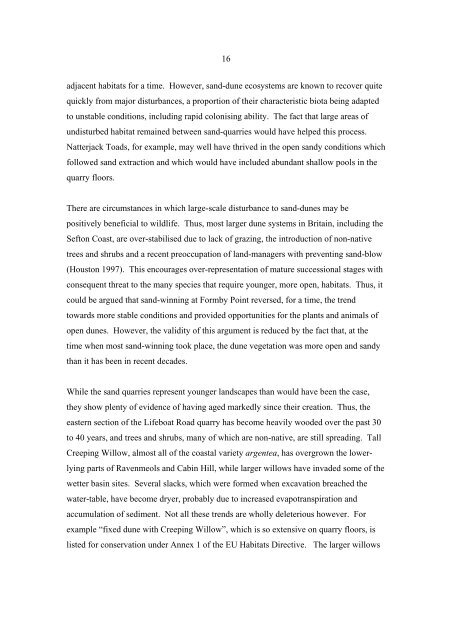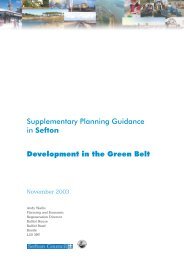The impact of sand extraction at Formby Point ... - Sefton Council
The impact of sand extraction at Formby Point ... - Sefton Council
The impact of sand extraction at Formby Point ... - Sefton Council
You also want an ePaper? Increase the reach of your titles
YUMPU automatically turns print PDFs into web optimized ePapers that Google loves.
16<br />
adjacent habit<strong>at</strong>s for a time. However, <strong>sand</strong>-dune ecosystems are known to recover quite<br />
quickly from major disturbances, a proportion <strong>of</strong> their characteristic biota being adapted<br />
to unstable conditions, including rapid colonising ability. <strong>The</strong> fact th<strong>at</strong> large areas <strong>of</strong><br />
undisturbed habit<strong>at</strong> remained between <strong>sand</strong>-quarries would have helped this process.<br />
N<strong>at</strong>terjack Toads, for example, may well have thrived in the open <strong>sand</strong>y conditions which<br />
followed <strong>sand</strong> <strong>extraction</strong> and which would have included abundant shallow pools in the<br />
quarry floors.<br />
<strong>The</strong>re are circumstances in which large-scale disturbance to <strong>sand</strong>-dunes may be<br />
positively beneficial to wildlife. Thus, most larger dune systems in Britain, including the<br />
<strong>Sefton</strong> Coast, are over-stabilised due to lack <strong>of</strong> grazing, the introduction <strong>of</strong> non-n<strong>at</strong>ive<br />
trees and shrubs and a recent preoccup<strong>at</strong>ion <strong>of</strong> land-managers with preventing <strong>sand</strong>-blow<br />
(Houston 1997). This encourages over-represent<strong>at</strong>ion <strong>of</strong> m<strong>at</strong>ure successional stages with<br />
consequent thre<strong>at</strong> to the many species th<strong>at</strong> require younger, more open, habit<strong>at</strong>s. Thus, it<br />
could be argued th<strong>at</strong> <strong>sand</strong>-winning <strong>at</strong> <strong>Formby</strong> <strong>Point</strong> reversed, for a time, the trend<br />
towards more stable conditions and provided opportunities for the plants and animals <strong>of</strong><br />
open dunes. However, the validity <strong>of</strong> this argument is reduced by the fact th<strong>at</strong>, <strong>at</strong> the<br />
time when most <strong>sand</strong>-winning took place, the dune veget<strong>at</strong>ion was more open and <strong>sand</strong>y<br />
than it has been in recent decades.<br />
While the <strong>sand</strong> quarries represent younger landscapes than would have been the case,<br />
they show plenty <strong>of</strong> evidence <strong>of</strong> having aged markedly since their cre<strong>at</strong>ion. Thus, the<br />
eastern section <strong>of</strong> the Lifebo<strong>at</strong> Road quarry has become heavily wooded over the past 30<br />
to 40 years, and trees and shrubs, many <strong>of</strong> which are non-n<strong>at</strong>ive, are still spreading. Tall<br />
Creeping Willow, almost all <strong>of</strong> the coastal variety argentea, has overgrown the lowerlying<br />
parts <strong>of</strong> Ravenmeols and Cabin Hill, while larger willows have invaded some <strong>of</strong> the<br />
wetter basin sites. Several slacks, which were formed when excav<strong>at</strong>ion breached the<br />
w<strong>at</strong>er-table, have become dryer, probably due to increased evapotranspir<strong>at</strong>ion and<br />
accumul<strong>at</strong>ion <strong>of</strong> sediment. Not all these trends are wholly deleterious however. For<br />
example “fixed dune with Creeping Willow”, which is so extensive on quarry floors, is<br />
listed for conserv<strong>at</strong>ion under Annex 1 <strong>of</strong> the EU Habit<strong>at</strong>s Directive. <strong>The</strong> larger willows















